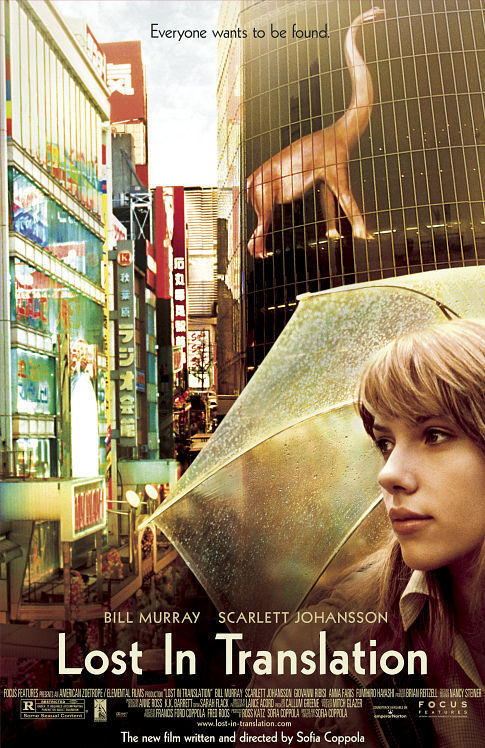Rolf Potts’ Favorite Films about Cities
Lost In Translation
1 Sofia Coppola’s understated intergenerational romance takes place against the backdrop of a Tokyo that is both incomprehensible and weirdly gorgeous. This is not a tale of seasoned travelers discovering the truths of a city; it is a story about two accidental tourists using the strangeness of a new place as an unwitting pretext to examine their own lives. When Bob and Charlotte (Bill Murray and Scarlet Johansson) leave the sterile cocoon of their Shinjuku hotel rooms and make tentative forays into the city (to a shrine, a subway, a game room, a karaoke lounge, a hospital), we discover Japan as they do — as outsiders, enjoying the simple moments of confusion, connection, and joy. Coppola doesn’t provide subtitles for the Japanese dialogue — nor does she indulge us in cheap cross-cultural epiphanies — and in this way she draws us into Bob and Charlotte’s culture-shocked disorientation as they make their private discoveries amid the neon sprawl of Tokyo.
Before Sunset
2 Perhaps the best thing about Richard Linklater’s romantic indie-sequel (co-written by actors Julia Delpy and Ethan Hawke) is that Paris is used as a setting for Céline and Jesse’s brainy intimacy — not as a clumsy symbol of romance itself. Indeed, apart from a well-timed glimpse of the Notre Dame cathedral, this is not a Paris of iconic landmarks and easy clichés; instead, it’s a real-time stroll through the anonymous beauty of the city’s Left Bank back-streets. As a veteran flâneur of these 5th arrondissement avenues (I teach a writing class in Paris each summer), I can attest that wandering the city at random is the best way to experience the splendor of Paris, regardless of whether or not you take an elevator to the top of the Eiffel Tower. Near the end of the film, Celine is herself startled by the spectacle of her own city as she and Jesse take a tourist boat down the Seine. “This is great; I’ve never done this,” she says. “I forget how beautiful Paris is.” In avoiding the obvious as he portrays the city, Linklater shows us just how deep that beauty can be.
Do The Right Thing
3 Though I’m not sure anyone has ever made this comparison, Spike Lee’s provocative 1989 film has a lot in common with Jean-Pierre Jeunet’s whimsical 2001 movie Amélie. Both films portray city neighborhoods (Bedford-Stuyvesant and Montmartre) with lyrical and mythic strokes — and both directors were accused of glossing over the seedier nature of their urban settings in the process. While Jeunet’s Paris is firmly rooted in fantasy, however, Lee’s New York feels disconcertingly real as the film explores racial tensions over the course of one witheringly hot day in Brooklyn. Cannes judge Wim Winders famously noted that Do the Right Thing doesn’t have any heroes — but this doesn’t make the film any less powerful as Lee’s flawed characters make their fateful decisions along the brownstone stoops and tree-lined avenues of “Bed-Stuy.”
Boogie Nights
4 Los Angeles is undoubtedly the most over-portrayed city in the history of film, but Paul Thomas Anderson’s L.A. isn’t Hollywood — it’s the San Fernando Valley, better known for its porn stars than its movie stars. Fittingly, Anderson’s breakout movie was Boogie Nights, a porn-themed ensemble piece that showed how the backyard pool parties and strip-mall nightclubs of Reseda can carry a nostalgic glamour all their own. The filmmaker’s Oscar-nominated 1999 follow-up to Boogie Nights took its name from one of the San Fernando Valley’s principal thoroughfares — Magnolia — and further illuminated the complicated texture of a place that is so close to (yet undeniably separate from) Hollywood.
About Schmidt
5 As a native son of flyover country (I grew up in Wichita, Kansas), I appreciate how Alexander Payne set his first three films (Citizen Ruth, Election and About Schmidt) in Omaha without ever resorting to the kind of knee-jerk sentimentality and condescension that mars so many cinematic portrayals of Midwestern America. In About Schmidt, Jack Nicholson’s character wanders his way through a wintry blue Nebraska that looks imposing and urban, even as it feels provincial and isolated. In this way, the city inhabits the screen not as an idealized postcard, but as dynamic character that lends to the mood of the movie. About Schmidt could have been shot anywhere, but the specificity of Omaha gave the film a unique resonance. As Payne told the New York Timeswhen explaining why he set his movies in Nebraska, “I hadn’t seen the Midwest in a movie. I wanted to see it. It was as simple as that.” Anyone who’s lived in a mid-sized, mid-American industrial city will see how Payne’s films ring that much truer as a result.

